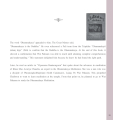Pali grammar : ค้นหาหนังสือธรรมะ หน้า 3 / 13
หน้าหนังสือทั้งหมด

8
Understanding Boonya and Kilesa in Buddhist Teachings
out how to remove it. We are trying to make this book as
neutral as possible, because when one comes to understand
the reality of these teachings and their applicability, you
will find that they are n
This text delves into the Pali Sanskrit terms Boonya and Kilesa, emphasizing their importance in Buddhist teachings. Boonya, described as self-generating pure energy, is crucial for understanding meri

59
The Importance of Chanting in Buddhism
your mind will clear and be open to receive merit. Your thoughts, speech, and action will not be led astray by temptation.
Performing Vatta serves constantly to remind us of the virtues of the Triple
Chanting in Buddhism plays a crucial role in enhancing faith and preserving teachings of the Buddha. It reminds practitioners of the virtues of the Triple Gem and helps them avoid temptation. Historic

2
บาลีไวยกรณ์และสนธิ
ประโยค - บาลีไวยกรณ์ สมัญญาภิธานและสนธิ - หน้าที่ 2
ของสิ่งเดียว ๑ ทวิวจนะ คำพูดถึงคนหรือของ ๒ สิ่ง ๑ พหุวจนะ
คำพูดถึงคนหรือของมาก ๑. ส่วนในบาลีภาษามิวจนะแต่ ๒ คือ
เอกวจนะ ๑ พหุวจนะ ๑ และในภาษาสันสกฤต
เนื้อหาเกี่ยวกับบาลีไวยกรณ์ โดยอธิบายความหมายและการจำแนกประเภทของคำในบาลีและสันสกฤต เช่น การแบ่งไวยากรณ์ออกเป็น 4 ส่วน ได้แก่ Orthography, Etymology, Syntax และ Prosody รวมถึงการแบ่งประเภทที่สำคัญในเอ

60
Understanding Dhammakāya: The Essence of Transcendental Dhamma
Arhatship (arahattamagga).86 Therefore, the particular path is not a mere ‘collective title’ of the path-constituents but the ‘essential totality’ by which a ‘body’ is defined.
The dependence of funct
This text discusses the concept of Arhatship and the definition of Dhammakāya in the context of Buddhist philosophy. It argues that the path should be seen as an essential totality, forming a 'body,'

68
Dhammakāya and Noble Disciples
VI. Reference 3: Dhammakāya and Noble Disciples
Besides the term’s relation to the Buddha and Paccekabuddhas, a Pāli canonical reference mentions also the relation of dhammakāya with noble disciples.
In the context of Pāli texts, the term dhammakāya is linked to noble disciples as evidenced in the story of Gotamī, the great nun and Buddha's foster mother. As she approaches her passing, Gotamī refl

61
The Pali Language and the Theravadin Tradition
NORMAN, K.R.
1983 “The Pali Language and the Theravadin Tradition.”
A History of Indian Literature: 1-2, edited by Jan Gonda. Wiesbaden: Otto Harrassowitz.
PEW Research Center.
2017 “World Bu
This text discusses the significance of the Pali language within the Theravadin Buddhist tradition. It examines its historical roots, literary contributions, and the ongoing impact on Buddhist practic

4
จักรึกสาแปลเดิมอัปลิมยำนนะ: จารึกอรรถกถากอภิวัฒน์ในประเทศไทย
จักรึกสาแปลเดิมอัปลิมยำนนะ: จารึกอรรถกถากอภิวัฒน์ในประเทศไทย
Octagonal Pillar Inscription from Chainat: the Oldest Inscription Recording Abhidhamma Attakathā Text in Thailand
57
U-tain WONGSATHIT
Ab
บทความนี้ศึกษาการอ่านและแปลจารึกเสาหมายเลขแปดเหลี่ยมจากจังหวัดชัยนาท ซึ่งเป็นจารึกจากอาณาจักรทวารวดี เขียนด้วยอักษรปัลลวะในช่วงศตวรรษที่ 6-7 ตามพื้นฐานของโบราณคดี เนื้อหาภายในจารึกเป็นภาษาพาลี โดยเฉพา

3
The Relationship between Jātaka Stories in Buddhist Scriptures and Bharhut Stupa Sculptures
The Relationship between Jātaka stories in Buddhist Scriptures and Those in Sculptures of Bharhut Stupa
Pramaha Pongsak THANIO
Abstract
This paper presents a study on the relationship between Jātaka
This study delves into the intricate relationship between the Jātaka stories found in Buddhist scriptures and the sculptures at Bharhut stupa. It identifies that many of these sculptures are rooted in

29
Perfections in Buddhism: Understanding the Ten Perfected Virtues
บาลี (parami) 'Perfected Virtues'; 'Perfections'; transcendental virtues
บาลี ๑๐ ทัศ Ten Perfected Virtues (Ten Perfections) consisting of generosity, self-discipline, renunciation, wisdom, patience,
ศึกษาความสำคัญของทัศ 10 ประการในพุทธศาสนา ซึ่งประกอบด้วยความเอื้อเฟื้อ, การมีสติ, การสละ, ปัญญา, ความอดทน, การเพียรพยายาม, ความจริงใจ, การตัดสินใจ, ความเมตตา และความเป็นกลาง การปฏิบัติตามทัศเหล่านี้เป

253
Buddhism Studies and Literature
Sam Nhean. (1957). The History of Buddhism in Cambodia. Phnom Penh : TraiRat
Saddhātissa, H. 1990. Pāli Literature of South-East Asia. Singapore: Singapore Buddhist Meditation Centre.
Sehrai, Fidaulla
This text contains references to significant works in the study of Buddhism, including historical accounts, Pāli literature from Southeast Asia, and studies on the influence of Indian Buddhism and its

97
Preservation of Palm-Leaf Scriptures in Dai Buddhism
donate palm-leaf scriptures as an act of merit and such donations
appear less frequently in the sacred dantam (贽坦) or offering
ceremony. Donors prefer to donate Buddhist scriptures printed
using mod
This text discusses the decline in donations of traditional palm-leaf scriptures in favor of more accessible and readable texts printed on Chinese and sa-paper. Reasons include cost, legibility, and t

82
Interpretations of Dhammakāya in Pali Commentaries
In addition to the above two commentators, Upasena and Buddhadatta141 are also Pali commentators who lived around the same times.142 Upasena agrees with Buddhagōsha in regard to his interpretations of
The text discusses the interpretations of the term 'dhammakāya' by various Pali commentators, focusing on Upasena and Buddhadatta, who align with Buddhagōsha, and their views on the Buddha's qualities

27
Exploring the Manuscripts of Nong Pa Fa Cave
The manuscripts of the Nong Pa Fa Cave have two forms of writing: Dham Lao from Laos, and Dham Lanna from northern Thailand. These two scripts are very similar, especially on manuscripts dating back s
The manuscripts of the Nong Pa Fa Cave showcase two primary forms of writing: Dham Lao from Laos and Dham Lanna from northern Thailand. While these scripts exhibit notable similarities, especially in

29
Introduction to Dhammakaya Meditation
The word “Dhammakaya” appealed to him. The Great Master said, “Dhammakaya is the Buddha.” He even referenced a Pali term from the Tripitika: “Dhammakayo (aham iti.pi,” (Pali) to confirm that the Buddh
The text discusses the meaning of Dhammakaya as the essence of Buddha, citing references from Pali texts. It mentions the influence of Khun Mae Acariya Chandra in advancing meditation practices and ho

50
Journey to Dhamma: A Personal Transformation
ERVICE
merits. If I had huge problems, I would make huge
merits. This was how I learned about Wat Phra
Dhammakaya in 2001, under the guidance of a good
fellow (kalyanamitta) from Korat who suggested t
This text chronicles a personal journey of spiritual growth, initiated by the author's experiences at Wat Phra Dhammakaya and the DMC program. From the suggestion of a friend, the author contributed t

316
ปัญหาเกี่ยวกับต้นกำเนิดของ Canon Pāli ในต้นฉบับสคริปต์ Khom ที่พบในประเทศไทยและกัมพูชา
“A Problem on the Origin of the Pāli Canon of Khom Script Manuscripts Found in Thailand and Cambodia”
ในส่วนการศึกษาวิจัยฉากาวการเปรียบเทียบเนื้อหาเบื้องต้นนี้ปรากฏในฉบับจริง เป็นการรบกวนเนื้อหาที่ปรา
การศึกษานี้มุ่งเน้นไปที่การเปรียบเทียบและวิเคราะห์ต้นฉบับ Canon Pāli ที่ใช้สคริปต์ Khom ในประเทศไทยและกัมพูชา โดยมีวัตถุประสงค์เพื่อค้นหาข้อสรุปที่ชัดเจนและพัฒนาเป็นฐานข้อมูลความรู้ทางพระพุทธศาสนา การ

40
Understanding Dhammakāya in Aṅgāṇā-sutta
In brief, contemporary academics refer to the term dhammakāya in the Aṅgāṇā-sutta either as a noun or an adjective. As a noun, the term is interpreted mostly as the Buddha’s teachings collected togeth
The term dhammakāya is interpreted in contemporary academia as both a noun and an adjective. As a noun, it denotes the Buddha’s teachings, while as an adjective, it refers to the nature of the Tathāga

559
Buddhist Literature and Manuscripts
Bailey, H. W. 1979. *Dictionary of Khotan Saka*. Cambridge: Cambridge University Press.
Banerjee, Anukul Chandra. 1979. *Sarvästivāda literature*. Calcutta: The World Press Private Limited.
Batchelor,
This collection features important works and studies related to Buddhist literature and manuscripts, covering a range of topics including the Khotan Saka dictionary, Sarvästivāda literature, and the s

164
Understanding Primary Path and Meditative Attainment
Primary Path: beginning stage of meditative attainment leading to more advanced stages of absorption.
Right View: view and wisdom in accordance with the Truths, consisting of the following beliefs: g
This text discusses the primary path of meditative attainment, highlighting the importance of right view as foundational beliefs that align with truth. Concepts such as Samadhi, denoting mental discip

13
The Universality of Meditation
The Universality of Meditation
tradition. Simply close your eyes and do nothing.
In other words, meditate. It is a practice that will
bring our lives happiness and fulfillment, which
we should take ut
Meditation is a universal practice that brings happiness and fulfillment. In Pali, 'natthi santiparam sukham' suggests that true happiness lies in peace of mind. This stillness can be achieved by anyo
